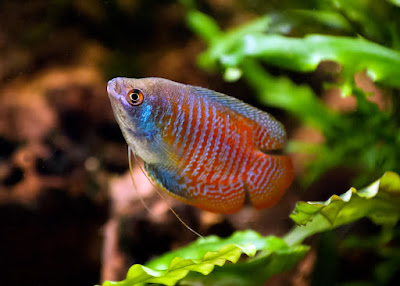Dwarf gourami are well known for their interesting reproductive behavior which includes bubble nesting and parental care...
Dwarf gourami, also know as Trichopodus lalius, Colisa lalia, Polyacanthus lalius, Colisa unicolor and its accepted scientific name Trichogaster lalius, has long been one of the most popular aquarium fish and among the gourami, it is second most important aquarium fish, adored by aquarists for its sparkling, almost translucent blue colouring accented with fine stripes of red or dark orange. They are also well known for their interesting reproductive behaviour which includes bubble nesting and parental care.
DWARF GOURAMI - TRICHOGASTER LALIUS DESCRIPTION
Dwarf gourami is native to Bangladesh, India (Uttar Pradesh, Arunachal Pradesh, Assam, Uttaranchal, West Bengal, Bihar, Manipur), Nepal and Pakistan. They are found in slow swimming streams plentiful vegetation, rivers, rice fields, irrigation channels and agriculture land.
Trichogaster lalius can reach 8.8 cm in length and will live for up to 4 years if kept in the correct water and habitat conditions. The body is egg shaped, strongly compressed. Mouth is small, directed upwards. Slightly concavity over nape, dorsal and anal fins are spiny. Base of soft dorsal and anal fins are covered with scales. They have an interesting adaptation called the Labyrinth organ which they can use to breath air. This allows them to survive in areas of low oxygen and poor water quality.
The wild form have alternating blue and red/orange vertical stripes covering the body, with the stripes extending into the fins. The females are generally a dull silvery blue colour. They have been selectively bred for many years to produce a variety of different colour forms such as: Blue Coral, Blue Rainbow, Rainbow Flame or Blood Red, Metallic Blue, and Neon. Colour is considered to be one of the major factors which determine the cost of aquarium fish in the world market.
It requires high protein feed for their growth and coloration. They take 8 to 12 months to mature in temperate areas like northern India. Males are in general a lot brighter in colour than females, with the colour intensifying during the breeding period. Females are smaller than males and not as brightly coloured with more rounded stomachs when holding eggs.
DWARF GOURAMI - TRICHOGASTER LALIUS CARE
Dwarf gourami do not appreciate fast-moving or turbulent water. Try to keep flow to a minimum in any set-up containing them. They do best in.tank of minimum 10 gallons with water temparature of 22 - 28°C, pH level of 6.5-7.5 and general hardness of 50-150 ppm. They prefer heavily planted aquariums with at least a portion of the tank covered with floating plants.
The addition of a dark substrate and floating vegetation is also recommended to calm these essentially shy fish. The addition of some twigs, branches and leaf litter could make for a very natural-looking set-up.
It’s generally not a good idea to keep a group of dwarf gouramis together and the species is usually sold in sexed pairs. Buying a male and female pair is by far the best way to keep this species. Even then problems can arise as males can be very hard on females on occasion.
They are a peaceful fish that is ideally suited to a small to medium sized community tanks that does not contain any predatory or aggressive fish. They can be kept with tetras, small barbs, native species such as Rainbowfish, as well as livebearers. Avoid keeping with large aggressive fish including some of the larger types of Gouramis.
Trichogaster lalius are omnivorous and in the wild feed on small insects and larvae from the top of the water. They also readily feed on algae and plant matter. In the aquarium, they will feed on most types of feeds including floating pellets or flake. They also feed live or frozen foods like Bloodworms and Brine shrimp. Feeding live foods is essential in conditioning fish for breeding.
DWARF GOURAMI - TRICHOGASTER LALIUS SPAWNING
Dwarf gourami are well known for their interesting reproductive behavior which includes bubble nesting and parental care. When male became mature; they started making bubble nest on the surface of the water. Male became aggressive in nature, their body colour became more prominent with vertical diagonal stripes of alternating red to dark orange that encountered into the fins and look more attractive. A deep lucent colour band was seen over the operculum in case of mature male. In case of female, their body colour became silvery or a dull silvery blue to gray colour and also the belly portion of the matured female looked bulge.
Once the nest is built the male will begin courting the female, usually in the afternoon or evening. If the female accepts the male she will begin swimming in circles with the male beneath the bubble nest. Then the female will release approximately five dozen clear eggs, which are immediately fertilized by the male. Most of the eggs will float up into the bubble nest and eggs that strayed are collected by the male and placed in the nest. The male guards the nest eggs and young until the fry can swim freely.
The incubation period is about 24 hours. Fry becomes free-swimming within 48 hours, after which time the male is also removed from the tank. Larvae are fed with live food immediately after yolk sac absorption. They are provided with a sufficient quantity of rotifers or infusoria for one week, ensuring that minimum effort is required to search for food. After one week of rearing, larvae are fed with Artemia nauplii, blood worms, sludge worms, or mixed zooplankton until they reach stocking size.
BUY DWARF GOURAMI - TRICHOGASTER LALIUS AND RELATED PRODUCTS














COMMENTS